Are Caracals Good Pets? No, caracals are not suitable as pets due to their wild nature, territorial behavior, and potential for aggression. PETS.EDU.VN aims to provide valuable information to help you make informed decisions about pet ownership, ensuring the safety and well-being of both you and the animal. Discover why it’s best to admire these exotic cats in their natural habitat and explore domestic breeds that offer a similar aesthetic without the challenges.
1. Understanding the Caracal: A Wild Cat
The caracal (Caracal caracal), often referred to as the desert lynx, is a wild cat species native to Africa, Central Asia, India, and the Middle East. Although called the desert lynx, it is not a true lynx. There are three subspecies of caracal: the Southern caracal (C. c. caracal), which is found in South Africa and East Africa; the Northern caracal (C. c. nubicus), which is found in North and West Africa; and the Asiatic caracal (C. c. schmitzi), found in Central Asia and India. Caracals are also found in the Middle East. These beautiful creatures possess unique characteristics that distinguish them from domestic cats.
- Long legs
- Short, tan or sandy colored coat
- Large, tufted ears
The black ear tufts are especially striking on this beautiful wild cat, which looks a bit like a cougar in miniature. Though small for a wild cat, caracals are quite a bit larger than most house cats. Adult caracals weigh about 20 to 40 pounds.
2. The Cat Family: Pantherinae vs. Felinae
To better understand the differences between caracals and domestic cats, it’s helpful to explore the cat family’s classification. All cats, both wild and domestic, belong to the Felidae family. This family is divided into two subfamilies: Pantherinae and Felinae.
2.1. Pantherinae: The Roaring Giants
The subfamily Pantherinae includes the big cats, such as lions, tigers, and jaguars.
| Species | Genus |
|---|---|
| Lion (Panthera leo) | Panthera |
| Tiger (Panthera tigris) | Panthera |
| Jaguar (Panthera onca) | Panthera |
| Leopard (Panthera pardus) | Panthera |
| Snow leopard (Panthera uncia) | Panthera |
| Mainland clouded leopard (Neofelis nebulosa) | Neofelis |
| Sunda clouded leopard (Neofelis diardi) | Neofelis |
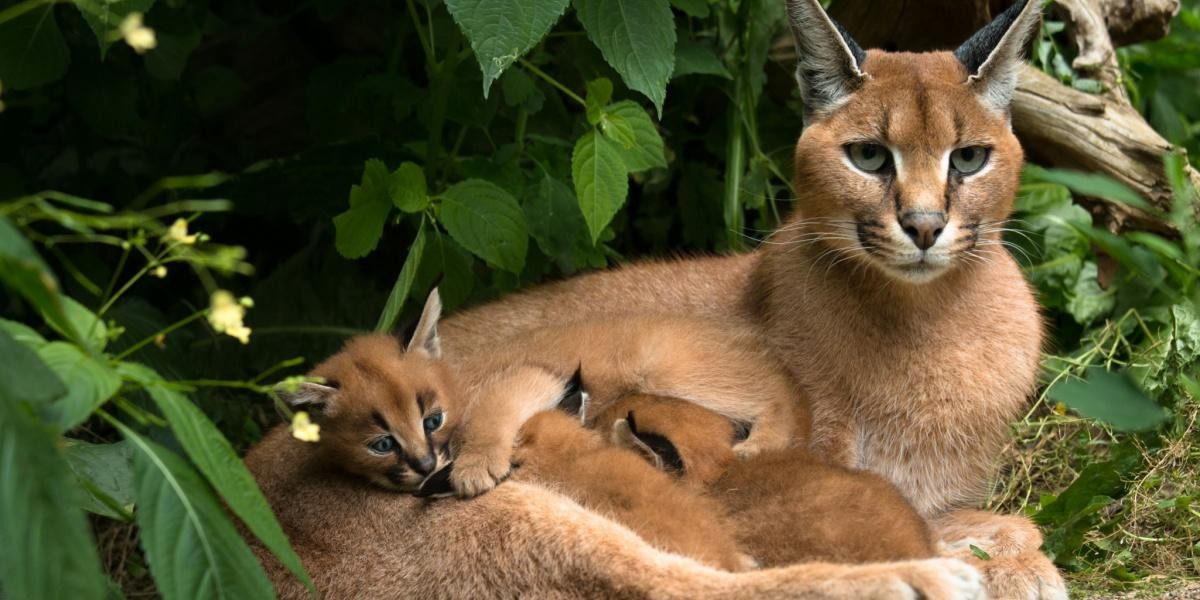
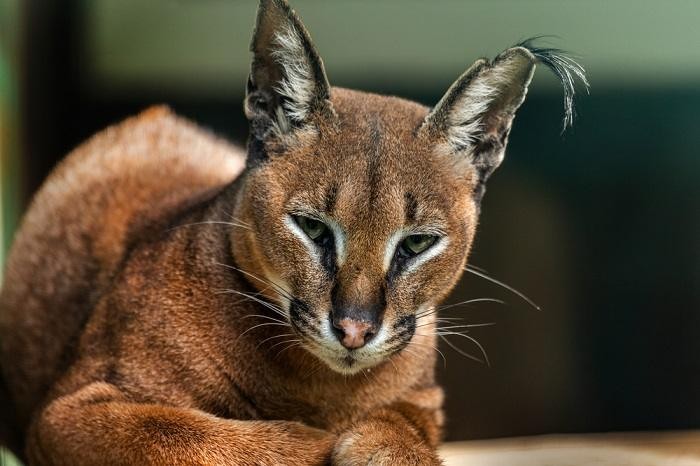
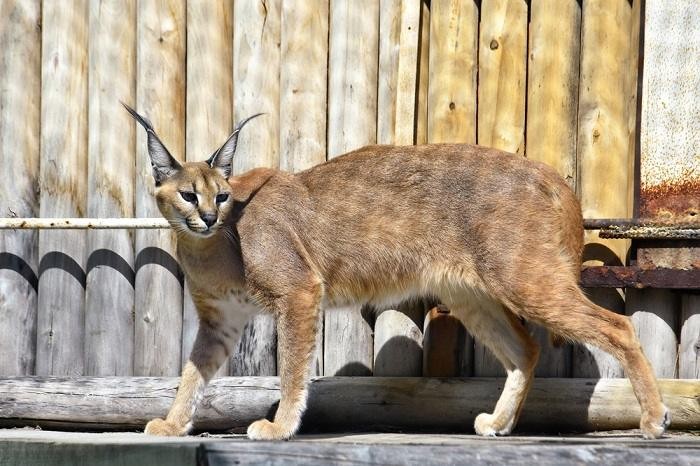
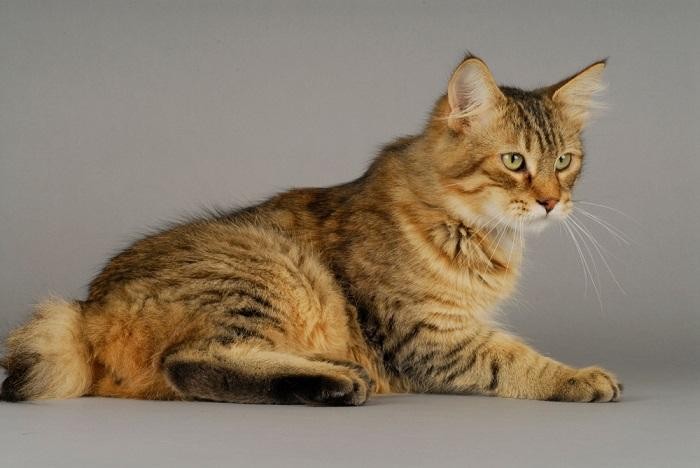
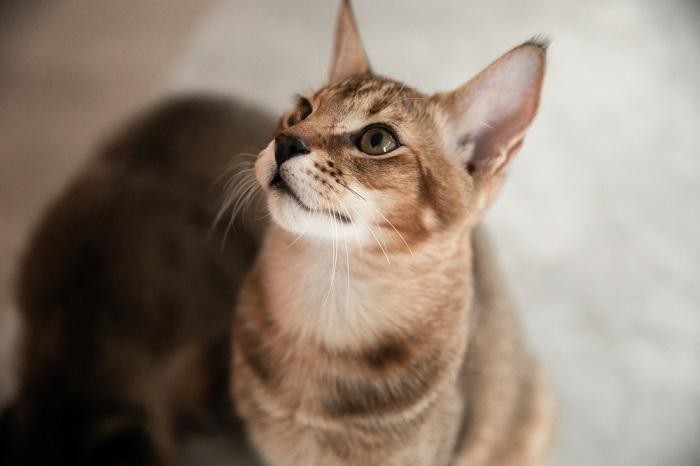
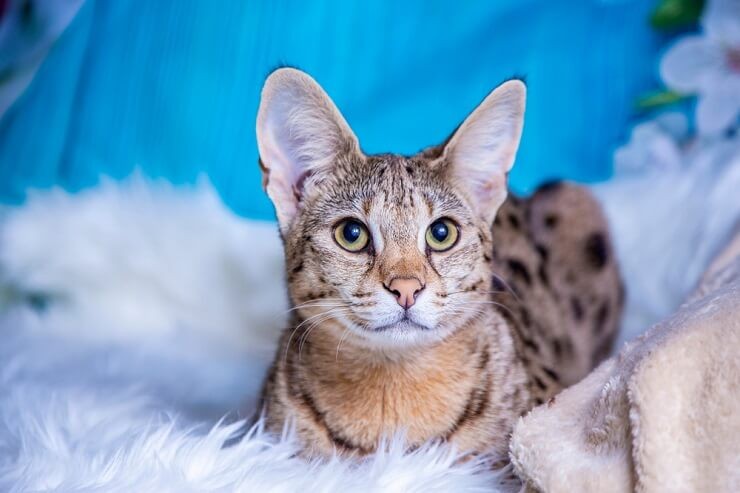
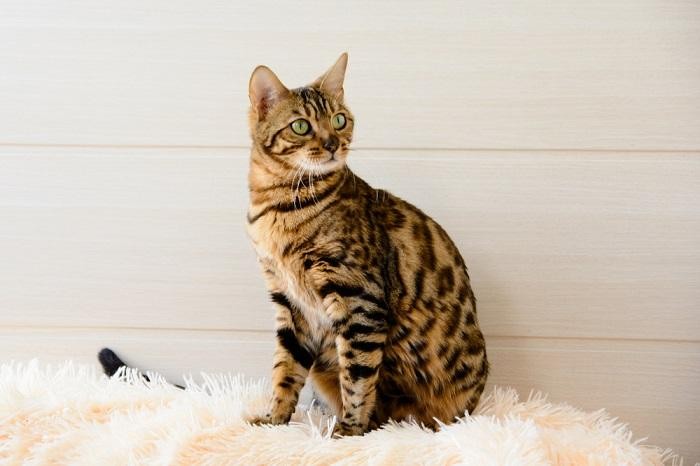
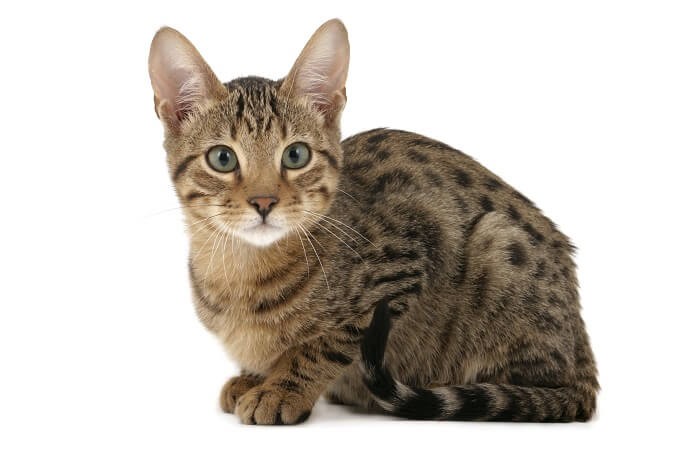
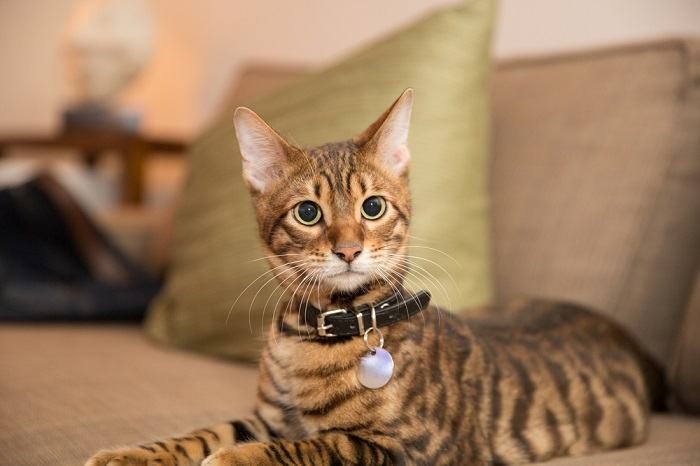
2.2. Felinae: The Purring Companions
The subfamily Felinae is much larger, containing various wild cat species and our beloved domestic house cats. Some common members include:
| Species |
|---|
| African wildcat |
| Asian golden cat |
| Bobcat |
| Caracal |
| Cheetah |
| Cougar |
| Domestic cat |
| Jungle cat |
| Leopard cat |
| Ocelot |
| Serval |
2.3. Roaring vs. Purring: The Hyoid Bone
An interesting distinction between these subfamilies lies in their ability to roar or purr. All members of Pantherinae (except the snow leopard) can roar but cannot purr like house cats. Conversely, all members of Felinae can purr but cannot roar. This difference is due to the hyoid bone, a small bone in the throat near the larynx. Pantherinae cats have a flexible hyoid, while Felinae cats have a bony hyoid, allowing purring but not roaring. Like all members of the subfamily Felinae, caracals can purr.
3. Caracals and Domestic Cats: A Distant Relationship
Caracals and domestic cats share membership in the Felinae subfamily, indicating a somewhat close relation. However, this doesn’t mean caracals can be easily tamed like domestic cats. Caracals are wild animals, retaining their wild instincts even in captivity.
Consider other Felinae members like cheetahs or cougars. Despite being related to domestic cats, they are unsuitable as house pets. Similarly, caracals possess inherent wild behaviors that make them challenging and potentially dangerous to keep as pets.
4. Why Caracals Don’t Make Good Pets: Understanding the Challenges
While the idea of owning a caracal might seem exciting, wildlife experts strongly advise against it. Several reasons highlight why caracals are best left in the wild.
4.1. Untamed Instincts: The Wild Side
Caracals, even those bred as pets, retain their wild instincts. They can be unpredictable and potentially dangerous. Wild instincts can trigger aggressive behavior towards humans, especially children, and other pets.
Caracals are large, strong animals with powerful jaws, sharp teeth, and claws. Even a single instance of aggression can cause severe harm, particularly to vulnerable individuals or other animals.
4.2. Territorial Behavior: Marking Their Territory
Caracals are highly territorial and can be quite messy. They often require specialized outdoor enclosures, not only for safety but also because they exhibit natural behaviors like scratching, urine spraying, and open defecation, which can cause significant damage indoors.
4.3. Veterinary Care: Finding Specialized Expertise
Finding a veterinarian willing to treat a caracal can be challenging. These cats require preventive care, vaccinations, and potential treatment for injuries or illnesses. You might need to seek out a wild animal veterinarian specializing in exotic cats, which can be expensive and require long-distance travel.
4.4. Dietary Needs: A Specialized Carnivore
Feeding caracals is both difficult and costly. As carnivores, they require a specialized diet, potentially including raw meat. In the wild, they hunt birds, rodents, hyraxes, hares, and even small antelopes and gazelles.
4.5. Natural Habitat: The Key to Happiness
Most importantly, wild animals, including caracals, thrive in their natural habitats. Unlike domestic cats, which have coexisted harmoniously with humans for thousands of years, caracals are not meant to live alongside humans. They cannot fully express their natural instincts in a safe and appropriate manner when confined to a human environment.
5. The Legal Landscape: Is Caracal Ownership Legal?
The legality of owning wild animals like caracals varies by state. Some states permit wild animal ownership with a special license or permit, while others outright ban it.
Even if caracal ownership is not explicitly prohibited in your state, it doesn’t make it a wise decision. Consider the ethical and practical implications of keeping a wild animal as a pet.
6. Cat Breeds That Resemble Wild Cats: Exotic Looks, Domestic Temperaments
If you’re drawn to the exotic appearance of a caracal but understand the importance of sticking to domesticated cats, several breeds offer a similar aesthetic without the challenges. Some of these breeds are hybrids, created using wild cat species in the early stages of development.
However, the hybrids mentioned below are fully established breeds accepted by The International Cat Association (TICA), far removed from their wild relatives. Some breeds were created using hybrid and domestic breeds, resulting in an exotic look with minimal wild blood.
Here are some cat breeds that offer a wild appearance with a gentle and friendly temperament:
6.1. Pixie-Bob: The Bobcat Look-Alike
The Pixie-Bob resembles a bobcat with its short tail and wild appearance. Despite claims of being a bobcat-domestic cat hybrid, this is untrue. The breed originated from a large, classic-patterned male cat with a short tail and a domestic female cat. Pixie-Bobs are loving, active, social, and often described as dog-like.
| Feature | Description |
|---|---|
| Origin | United States |
| Height | 10″-12″ |
| Adult Weight | 8-18 pounds |
| Life Span | 13-16 years |
| Group | Medium-to-large sized short-haired |
| Price | $1800 – $3000 |
6.2. Chausie: The Jungle Cat Hybrid
The Chausie is ideal for those attracted to the caracal’s look, with its sandy, reddish-brown, or gray fur resembling the caracal’s coat. This hybrid breed was developed in the 1990s by crossing a jungle cat (Felis chaus) with domestic cats. Chausies are active, athletic, and sociable.
| Feature | Description |
|---|---|
| Origin | Egypt, South Asia |
| Height | 14″-18″ |
| Adult Weight | 12-25 pounds |
| Life Span | 10-15 years |
| Group | Large short-haired |
| Price | $500-$2500 |
6.3. Savannah: The Serval Hybrid
The Savannah is a hybrid breed resulting from crossing an African serval with domestic cats. Savannahs are curious, outgoing, and assertive. They enjoy playing in water and require ample exercise and mental stimulation.
| Feature | Description |
|---|---|
| Origin | United States |
| Height | 10″- 13″ |
| Adult Weight | 9-15 pounds |
| Life Span | 12-15 years |
| Group | Large-sized short-haired |
| Price | $1,500 – $25,000 (depending on generation) |
6.4. Bengal: The Leopard Look-Alike
The Bengal is another hybrid breed created by breeding domestic cats with the Asian leopard cat (Prionailurus bengalensis). Bengals have unique coat patterns, with some featuring rosettes resembling those of leopards, jaguars, and ocelots. Bengals are energetic, outgoing, curious, and affectionate.
| Feature | Description |
|---|---|
| Origin | United States |
| Height | 13″-16″ |
| Adult Weight | 6-15 pounds |
| Life Span | 12-20 years |
| Group | Large shorthair |
| Price | $1,500 – $3,000 |
6.5. Serengeti: The Serval-Inspired Breed
Although bred to resemble the African serval, the Serengeti contains no serval blood. This breed was created using Bengals and Oriental Shorthairs. The limited wild cat blood comes from the Bengal, which originated from the Asian leopard cat. Serengetis are confident, friendly, and active, often communicating through meows.
| Feature | Description |
|---|---|
| Origin | United States |
| Height | 8″- 10″ |
| Adult Weight | 8-15 pounds |
| Life Span | 8-12 years |
| Group | Medium-sized short-haired |
| Price | $600 – $2,000 |
6.6. Toyger: The Miniature Tiger
The Toyger was developed to resemble a tiger in miniature but contains minimal wild cat blood. The breed was initially created using a domestic cat, a Bengal, and a street cat from India. Toygers have a distinctive coat with bold vertical stripes and circular markings on the head, similar to a tiger’s markings. Toygers are docile, intelligent, and friendly.
| Feature | Description |
|---|---|
| Origin | United States |
| Height | 8″- 10″ |
| Adult Weight | 7-15 pounds |
| Life Span | 12-15 years |
| Group | Medium-sized short-haired |
| Price | $1200 – $3000 |
7. Essential Considerations: Caracals as Pets
Owning a caracal presents significant challenges, including potential aggression, territorial behavior, specialized care requirements, and legal considerations. PETS.EDU.VN advises against keeping caracals as pets, emphasizing the importance of respecting their wild nature and ensuring their well-being in their natural habitat.
7.1. Caracals and Human Interaction
Caracals are not naturally inclined to be friendly towards humans. In the wild, they are solitary animals preferring to live alone. Even caracal kittens bred for the pet trade retain wild instincts, including an aversion to human interaction.
7.2. Aggressive Tendencies in Caracals
Caracals, even those bred for sale as pets, retain their wild instincts and can exhibit aggression towards humans and other animals. While caracals raised from kittens might learn to tolerate human presence, they remain unpredictable and potentially dangerous.
7.3. Potential Harm from Caracals
Although caracal attacks on humans are rare due to their size, they can occur, particularly when these exotic animals are kept as pets. Any wild animal, including caracals, can be dangerous if cornered or threatened. Caracals are more likely to harm children and the elderly and can injure or kill other pets.
7.4. The Cost of Owning a Caracal
Breeders raise and sell caracals as pets, often at exorbitant prices. However, wildlife experts strongly advise against keeping caracals as pets, even if it is legal in your state, due to the ethical and practical concerns involved.
8. Frequently Asked Questions About Caracals as Pets
8.1. Are caracals friendly to humans?
No, caracals are not inherently friendly towards humans. They are solitary animals in the wild and retain their wild instincts even when bred as pets.
8.2. Is a caracal cat aggressive?
Yes, caracals can be aggressive. They retain their wild instincts and can be unpredictable, even dangerous, towards humans and other animals.
8.3. Can a caracal hurt you?
Yes, caracals can inflict harm, especially on children, the elderly, and other pets. Their powerful jaws and sharp claws can cause serious injuries.
8.4. How much does a caracal cost?
Caracals can cost a significant amount of money to purchase from breeders, but the ethical and practical implications of owning one should be carefully considered.
9. Alternatives to Caracals: Domestic Breeds with Exotic Looks
For those captivated by the appearance of wild cats, several domestic breeds offer a similar aesthetic without the challenges and ethical concerns of owning a caracal. These breeds include:
- Pixie-Bob
- Chausie
- Savannah
- Bengal
- Serengeti
- Toyger
These breeds provide the exotic look you desire with the gentle temperament of a domestic cat.
10. Responsible Pet Ownership: Making Informed Choices
PETS.EDU.VN encourages responsible pet ownership and informed decision-making. Keeping a caracal as a pet poses significant challenges and raises ethical concerns. By choosing a domesticated breed with a similar appearance, you can enjoy the companionship of a beautiful and well-behaved cat while respecting the natural habitat and instincts of wild animals.
Remember, responsible pet ownership involves understanding the specific needs of your chosen animal and providing a safe, nurturing environment where they can thrive. PETS.EDU.VN is here to support you with reliable information and resources to help you make the best choices for your furry friends.
For more information on responsible pet ownership, exotic cat breeds, and veterinary care, visit pets.edu.vn or contact us at 789 Paw Lane, Petville, CA 91234, United States, or Whatsapp: +1 555-987-6543. Explore our website for expert advice and valuable resources to ensure the health and happiness of your pets.